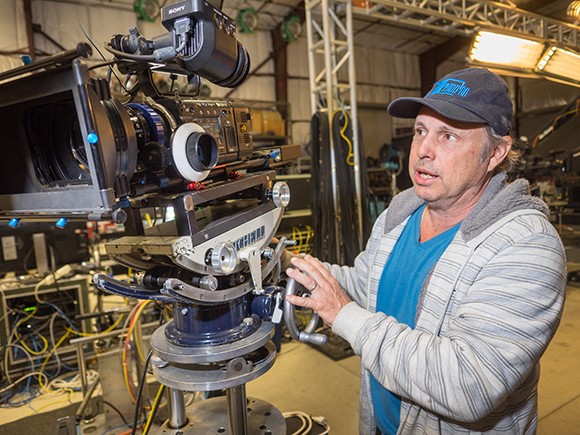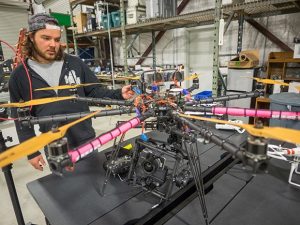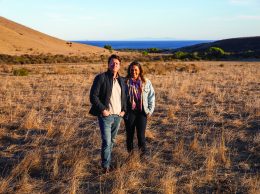Legendary family unwraps Creston film studio
IN THIS ARTICLE
- Central Coast Topic
- Erika Martin Author
By Erika Martin Friday, March 6th, 2015

Todd Fisher, CEO of Hollywood Motion Picture Experience, standing next to their camera equipment set up in Studio 32. (Nik Blaskovich / Business Times photo)
At a studio tucked in among the dirt roads in San Luis Obispo County’s foothills, long-time Creston resident Todd Fisher is prepared to shake up feature film production by bringing the flair and craftsmanship of old Hollywood to a completely new setting.
Fisher has been building up one of the world’s most enviable caches of movie equipment at his 44-acre Freedom Ranch for more than 25 years, waiting for the right time to realize his dream. The journey will come to a head at the end of next month when Fisher’s Hollywood Motion Picture Experience, or HMPE as it is called, begins filming its first full-length feature, a $3 million budget coming-of-age story called “Emerald Bay.” It will be the first movie to put Central Coast communities in the spotlight.
The son of “Singin’ in the Rain” star Debbie Reynolds and actor Eddie Fisher, and the brother of “Star Wars” actress Carrie Fisher, Todd grew up on movie sets. Though the rest of his family was drawn to the limelight, he was fascinated by the technical aspects of film and went on to hone his craft under cinematographer Harry Stradling and director-producer George Sidney, as well as producer Michael Todd, a family friend for whom he was named.
Most of Fisher’s camera and lighting inventory is the legacy of his previous project on the property, a 10,000-square-foot museum he built as a museum for the $30 million archive of Tinsel Town memorabilia collected by his mother, Reynolds. But after multiple failed attempts, the family abandoned the museum initiative and auctioned off artifacts including Judy Garland’s ruby slippers and one of Charlie Chaplin’s bowler hats.
With high costs and congestion continuing to push productions away from Los Angeles, Fisher saw he had the resources to harness the Central Coast’s pastoral beauty and launch a studio. When lower costs of living and running a film business are considered, Fisher said, the Creston facilities cost 20 times less than they would in L.A.
Roy Wagner, the studio’s director of photography, said running a studio had been a dream of Fisher’s since he was a teenager.
“This is just the beginning of the culmination of his dreams,” Wagner said. “He’s more than a visionary. He really is an impresario, just like his mentors and parents.”
According to Wagner, Fisher’s upbringing endowed him with an eclectic skill set with expertise touching on just about every aspect of filmmaking.
“I’m a two-time Emmy Award winner, and he probably knows more about my job than I do,” Wagner said. “He grew up in the movie business. It would have been impossible for him not to learn.”
Fisher has recruited a cadre of like-minded artists as department heads, from Wagner, whose other accolades include making Kodak’s Top 100 Directors of Photography in the World list; to Dusty Ebsen, son of Buddy Ebsen, who is head of post-production; to Emmett Alston, a noted experimental film director who will serve as a producer. The endeavor will also be a family affair, with CEO Todd’s mother Debbie and sister Carrie signing on as producers and possibly starring in their first film together for “Emerald Bay.”
Fisher hopes the tight-knit group of professionals can develop an atmosphere that harkens back to classic Hollywood studios. Aside from the department heads, the remainder of the film’s production crew will be recruited from the Central Coast, and the main character’s love interest will be played by Matthew Evans, a student at Cuesta College who starred in “Bad Teacher” alongside Cameron Diaz.
Fisher kept much of the family’s cadre of rare and high-quality production equipment away from the auction blocks to endow HMPE with a wealth of resources.
“Most filmmakers that you see have to rent all of this,” he said. “I can have all this sitting around — whether I use them today, tomorrow, next week or not at all is irrelevant right now. But I have available the best tools to make the best product, and I own them all and I don’t have any debt.”
Some of his cameras and bases are the only ones of their kind under private ownership, and Fisher said many of these capture color and light with characteristics that can’t be recreated by anything on the market.
“If you’re trying to get a certain type of look, people are really starting to wise up to the fact that the old heads are better than the new heads,” Fisher said. “People say, ‘Oh, I can just make my movie on an iPhone,’ and I’m not saying you can’t do that, but there is a technique and advantages to having these great tools. You get great production value.”
Fisher keeps three legacy film cameras in his active inventory, as well as a collection of archaic lighting technology, such as a rare 10,000-watt Fresnel light originally used for pin-up glamour shots. He also has a Panavision camera used to film the original Star Wars that he sold a similar model of three years ago for $600,000, breaking value records for science fiction and camera memorabilia.

Associate Producer John Haas shows a custom built camera drone in Studio 32 at Hollywood Motion Picture Experience.
But Fisher places just as much importance on using new-school technology to create something fresh and imaginative. The studio’s sound department, for example, has the best equipment available on the market, Fisher said. “Nobody even has some of the things we have in the types of quantities we have it in, because my background is to do something right or don’t do it at all.”
The facilities allow clients to produce high-definition programs with microscopic overhead, and a handful of local companies who had been traveling out-of-state to produce videos will begin renting HPME’s green-screen stage for creating infomercials or clips in a mock talk-show environment. HPME has also been working to foster collaboration and innovation among SLO’s underground community of film professionals, forming cross-promotion partnerships with local companies like Really Right Stuff, which manufactures user-friendly camera equipment.
Next to the 6,000-square-foot sound stage is a 10,000-square-foot building that houses three editing bays; a recording studio; hair, makeup and wardrobe; a prop department; and meeting rooms and offices. The expansive property is scattered with structures designed for film sets and is anchored by Fisher’s 7,800-square-foot home that bustles with activity throughout the day.
The studio also has three drones for overhead shots, from consumer models equipped with GoPro-type cameras to a custom-built craft that can carry up to 30 pounds of equipment. And if clients’ work can’t be shot on the ranch, they can use a mobile studio unit capable of delivering high-definition video feeds in real time.
HMPE owns the rights to about 20 scripts, ranging in budget from $1 million to $15 million, but chose to debut with “Emerald Bay,” a story adapted from a book by Paula Kennedy about defying her high-class family’s expectations to become a veterinarian. Although originally set on the East Coast, Fisher convinced Kennedy to let him adapt the story for San Luis Obispo after introducing her to the region.
“It embraces the wine culture, embraces the San Luis Obispo culture and lifestyle we all have here, and why we all came here,” Fisher said.
Fisher said “Emerald Bay” is similar to “Sideways” in certain aspects, and he is conscious of the heavy influence the latter wielded over the Santa Ynez Valley’s wine culture. He said the team places special importance on selecting its vineyard partner and has enlisted Mike Mooney of Chateau Margene as wine consultant to help identify the vineyard that will best represent the region’s wine industry at large.
Equestrian scenes will be filmed at Templeton Horse Park, Fisher said, and the movie will showcase surrounding communities such as Morro Bay, Pismo Beach and Paso Robles “as much as we can.” Fisher is also orchestrating a number of pro-bono placements for local businesses in the movie but hopes an influx of tourism can be properly managed by city and county officials.
“Emerald Bay” focuses on the relationship between the lead character, a teenager, and a horse, which Fisher acknowledges “has been done thousands of times, but it is one of those things that always works.”
But to make it fresh, he wanted to endow the equestrian scenes with greater depth of feeling than horse actors are usually capable of delivering. After studying films like “National Velvet” and “The Black Stallion,” Fisher realized he could show viewers the world reflected through the mare’s eyes by shooting a scene as the horse would view it then transposing the footage into its eye.
Fisher said technology “really enhances the way the filmmaker can get into the mind of the horse, which otherwise wouldn’t be very easy. It is a little thing — it’s only used a dozen or so times in the movie — but it should be a very unique thing.”










